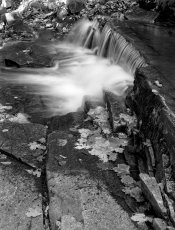Shadow separation is determined by the toe. Fact, not opinion. In a high contrast scene, HP5 cannot handle deep shadows without resorting to either overexposure or compensated development, each of which carries a penalty to both midtone and highlight tonality. If you just happen to prefer a particular look, that's fine. I happen to like both HP5 and TMY, but for different reasons. I've shot and printed an awful lot of HP5 in 8x10; I don't care much for it in smaller formats. But I had to resort to unsharp masking to reign in high contrast subjects in order to still hold excellent microtonality in the midtones. Compressed or minus or "pull" development just squishes everything together, flattening it; so I try to avoid that kind of option. There's just too much of a toe on HP5 to bag very long scale scenes without resorting to supplementary tricks. But the straight line of TMY, in the right developer, can go fully two stops or steps further down at full box speed. So, in effect, in some situations, it's a faster film too. But if you expect optimal performance, TMY has to be more carefully metered for the shadows. It's not a shoot-from-the hip film. On rainy days, under subdued or soft lighting, when I want a film better suited to quickie snapshooting, and don't mind a bit of conspicuous grain, Delta 3200 is one of my favorites. I rate it at 800, so really not that far off the current 400 speed topic.



